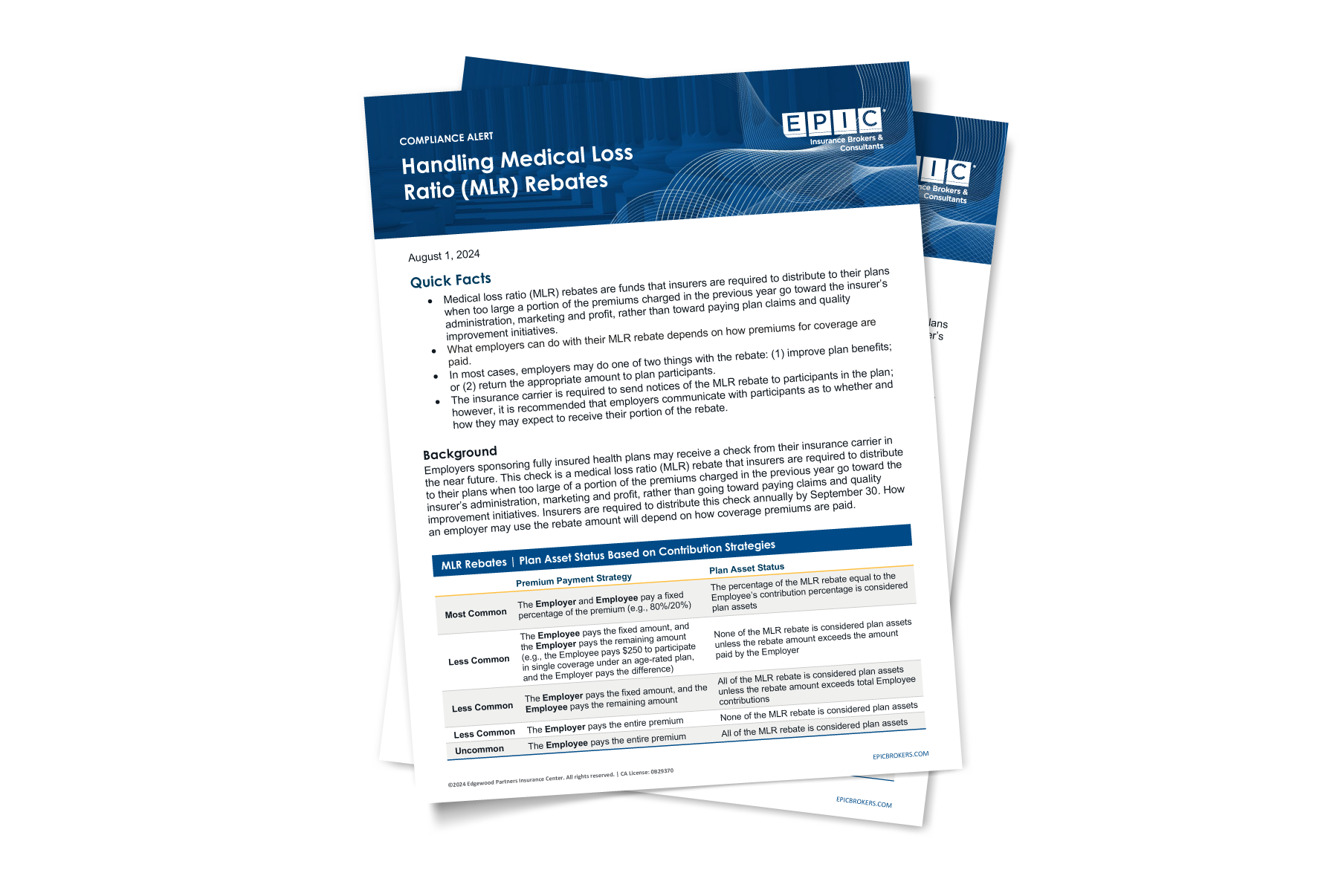Let our team help you navigate the ever-changing benefits compliance landscape each month. Check out this month’s latest alerts, additional updates, and resources hot off the press:
Employee Benefits Compliance Alerts
This month’s Compliance Matters newsletter provides a comprehensive review of the following topics. To obtain your copy, please use the form below to download.

- Special Alert: 2025 Health FSA & Qualified Transportation Limits
- Gag Clause Prohibition Attestations Due December 31, 2024
- Employee Benefits Litigation Series: Tobacco Surcharge Lawsuits Charge Forward
- 2024 State Regulation Series: California Legislative Updates on Dental, Record Review, Fertility & Claims
- 2024 State Regulation Series: State Individual Mandate & Employer Reporting Requirements
Download this month’s alerts
Additional Updates & Resources
CMS Releases 2026 ACA OOPM Limits
On October 8, 2024, the Centers for Medicare and Medicaid Services (CMS) provided guidance that sets forth the 2026 out-of-pocket maximum (OOPM) limits that may apply for group health plans under Affordable Care Act (ACA) rules. For 2026, the OOPM for self-only coverage is $10,150 and the maximum OOP for family coverage is $20,300. This is an increase over the OOP maximums in place for 2025, which are $9,200 for self-only coverage and $18,400 for family coverage. Plan sponsors should review the CMS guidance when determining plan designs for 2026.
Supreme Court Will Likely Take Up PBM Preemption Case
In October, the Supreme Court of the United States (SCOTUS) asked the Solicitor General of the United States, to file a brief in the case PCMA v. Mulready. This indicates that SCOTUS will likely take up the case.
The case arises from a 2023 U.S. Tenth Circuit Court of Appeals ruling that invalidated an Oklahoma law regulating pharmacy benefit managers (PBMs) on the grounds that the state law violates preemption rights under the Employee Retirement Income Security Act (ERISA). In July 2024, 32 state Attorneys General joined together to file an amicus brief writ of certiorari to the Supreme Court, petitioning them to grant Oklahoma’s request to review the Tenth Circuit decision. The Tenth Circuit decision creates a split in the law, which leads to uncertainty from the states on how to regulate PBMs. You can access our August 2024 alert on the amicus brief for more information, and our September 2023 alert about the Mulready case for more information.
EPIC will continue to monitor this case and provide updates as they develop. A SCOTUS ruling on this issue will hopefully bring uniformity to these state laws and put this ERISA preemption issue to rest.
Reminder! New Fixed Indemnity Model Notice
The Departments of Health and Human Services (HHS), Labor, and the Treasury (collectively, the Departments) released final rules earlier this year that established a new requirement to provide a consumer notice regarding Fixed Indemnity Excepted Benefits and Short-Term, Limited-Duration Insurance (STLDI) coverage in the group market. Access our October Compliance Matters update for more information.
As part of the Final Rule, Group Plan Sponsors must provide the new consumer notice for plan years starting on or after January 1, 2025. The model notice has specific content and formatting requirements and must be provided to eligible individuals before they enroll or reenroll in fixed indemnity benefits. While the notice may be provided with other materials, it must be displayed prominently to ensure plan participants recognize it.
The notice must appear on the first page of any marketing, application and enrollment (or re-enrollment) materials, whether in paper or electronic form, in at least 14-point font. What constitutes marketing, application and enrollment materials that must include the notice is often fact-specific. The preamble of the regulations indicates marketing materials “include any documents or website pages that advertise the benefits or offer an opportunity to enroll (or reenroll) in group market fixed indemnity excepted benefits coverage.”
For stand-alone materials that only reference or discuss the hospital indemnity plan, the notice must appear on the first page of those materials before any other information. Where the information on the hospital indemnity plan is bundled with information on other benefits (e.g., in a benefit guide), the agencies have acknowledged it will often be clearer if the notice appears in the guide immediately before the information on the hospital indemnity plan rather than as the first page of the bundled material where it may not be obvious as to which plan the notice applies.
In the case of electronic materials, like an online enrollment portal, it should be sufficient if the notice appears on the screen immediately before, or on the same screen as, where the employee actually enrolls in the hospital indemnity plan. The regulations indicate it is not sufficient to merely include a link employees can click to access the notice; the notice itself must be displayed in the portal immediately before the place where the employee enrolls in the benefit.
The model notice can be found within the Final Rules.
SBC Taglines Updated for 2025
For purposes of determining what language services and notice taglines are required for group health plans, the Culturally and Linguistically Appropriate Services (CLAS) County Data was updated and provided by CMS in late 2023 along with an agency frequently asked question (FAQ) guide.
The 2023 CLAS Guidance includes sample taglines stating how to access the language services provided by the plan or issuer in each of the languages that meet the 10% threshold. Non-grandfathered group health plans and health insurance issuers offering non-grandfathered health insurance coverage are required to provide summary of benefits coverages (SBCs) as well as claims and appeals notices in a manner that is consistent with the 2023 CLAS Guidance effective for plan years beginning on or after January 1, 2025.
In the FAQ, the Departments state they intend to update the following documents to reflect the updates in the 2023 CLAS Guidance; however, as of the date of the publication of this alert, no updated documents have been provided:
- SBC template and sample completed SBCs in English (with updated taglines in applicable non-English languages);
- Additional translated versions of the SBC and Uniform Glossary; and
- Model notices for internal claims and appeals and external review (with updated taglines in applicable non-English languages).
EPIC will continue to monitor the Departments’ website for more information and updated documents. Employers should confirm with TPAs and carriers that additional taglines will be included in SBCs for plan years beginning on or after January 1, 2025. For more information on the SBC requirement, access our January 2024 alert.
2026 Proposed Notice of Benefit Payment Parameters
Earlier this year, in the 2025 Final Notice of Benefit Payment Parameters (NBPP) the Departments codified the requirement that prescription drugs in excess of those covered by the State’s Essential Health Benefit (EHB) benchmark plan are considered EHBs, and therefore subject to the Affordable Care Act (ACA) prohibitions on annual and lifetime maximum limits. At the time, the Departments stated they intended to propose rulemaking that would align the standards applicable to large group market health plans and self-insured group health plans so that all group health plans and health insurance coverage would be subject to that requirement.
The 2026 NBPP finalizes the 2025 requirements for State EHB benchmark plans and reiterates the intention to extend the rule to large group health plans and self-funded plans. The NBPP does not provide additional rules for these group health plans, but we can expect to see additional rules in subsequent guidance.

More Compliance Resources
- Sign up for our in-depth 2024 Compliance Webinars
- Learn about our Compliance Consulting Services

WANT TO GET COMPLIANCE MATTERS IN YOUR INBOX?
Sign up for the monthly newsletter.
